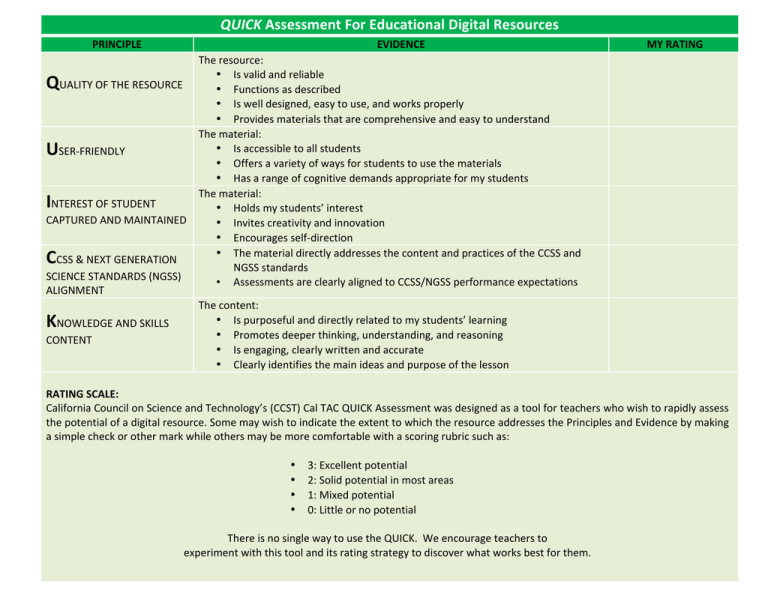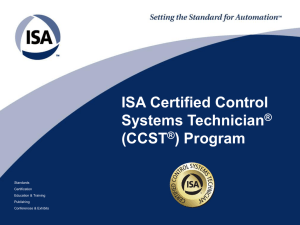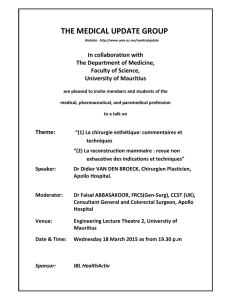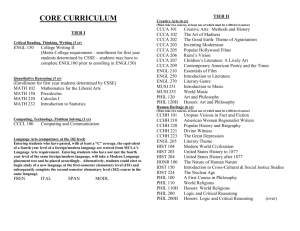QUICK Assessment For Educational Digital Resources
advertisement

QUICK Assessment For Educational Digital Resources PRINCIPLE EVIDENCE MY RATING The resource: • Is valid and reliable UALITY OF THE RESOURCE • Functions as described • Is well designed, easy to use, and works properly • Provides materials that are comprehensive and easy to understand The material: • Is accessible to all students SER-­‐FRIENDLY • Offers a variety of ways for students to use the materials • Has a range of cognitive demands appropriate for my students The material: NTEREST OF STUDENT • Holds my students’ interest CAPTURED AND MAINTAINED • Invites creativity and innovation • Encourages self-­‐direction • The material directly addresses the content and practices of the CCSS and CSS & NEXT GENERATION NGSS standards SCIENCE STANDARDS (NGSS) • Assessments are clearly aligned to CCSS/NGSS performance expectations ALIGNMENT The content: • Is purposeful and directly related to my students’ learning NOWLEDGE AND SKILLS • Promotes deeper thinking, understanding, and reasoning CONTENT • Is engaging, clearly written and accurate • Clearly identifies the main ideas and purpose of the lesson RATING SCALE: California Council on Science and Technology’s (CCST) Cal TAC QUICK Assessment was designed as a tool for teachers who wish to rapidly assess the potential of a digital resource. Some may wish to indicate the extent to which the resource addresses the Principles and Evidence by making a simple check or other mark while others may be more comfortable with a scoring rubric such as: • 3: Excellent potential • 2: Solid potential in most areas • 1: Mixed potential • 0: Little or no potential There is no single way to use the QUICK. We encourage teachers to experiment with this tool and its rating strategy to discover what works best for them. Q U I C K QUICK Assessment For Educational Digital Resources • • • • • Educational technologies are entering our education systems at a remarkably fast pace, and thousands of teachers are often left on their own to decide which, if any, digital resources will effectively enhance instruction and advance their students’ learning. To address this need, members of the California Council on Science and Technology’s (CCST) California Teacher Advisory Council (Cal TAC) offer this tool for teachers and other educators to help guide the selection of appropriate digitally enhanced resources. It is not meant to take the place of more comprehensive assessment systems for evaluating the effectiveness of digital platforms, apps, and resources, but rather provides a “quick” screen of prospective quality and utility of educational technology in a classroom, afterschool, or informal setting. Whether planning lessons, working directly with students, or in some other learning context, we hope that applying the Quick Assessment will help educators navigate this rapidly expanding area of the education landscape. This tool was developed with input from many classroom teachers who have tested the criteria in varying contexts; we anticipate continuing refinements will be added as its use spreads. For those looking for ways in which to look more deeply at the effect of digital resources, many more sources are beginning to emerge. For example, please see the Rubrics for Evaluating Open Education Resources (OER) Objects (Achieve: www.Achieve.org), Graphite (Common Sense Media: www.graphite.org), and CLRN (California Learning Resource Network: www.clrn.org). We would like to thank the staff and boards of the Stephen D. Bechtel, Jr. and Stuart Foundations for their interest in and support of advancing effective digital teaching and learning throughout the state. Copyright 2014 by the California Council on Science and Technology ISBN: 978-­‐1-­‐930117-­‐89-­‐1 QUICK Assessment for Education Digital Resources CCST is a non-­‐profit organization established in 1988 at the request of the California State Government and sponsored by the major public and private postsecondary institutions of California and affiliate federal laboratories in conjunction with leading private-­‐sector firms. CCST catalyzes leading experts in science and technology to engage with decision-­‐makers with the goal to ensure California’s continued leadership in science, technology, innovation, and science education. As a part of CCST, Cal TAC is a group of outstanding K-­‐14 science and math classroom teachers that provides a voice for the STEM educator community, involving teachers in discussions of education related policy. Cal TAC produces studies and makes recommendations on issues important to STEM education and interfaces directly with teachers and policy makers. For questions or comments on this publication contact: California Council on Science and Technology 1130 K Street, Suite 280 Sacramento, California 95814 (916) 492-­‐0996 – ccst@ccst.us ccst.us/ccstinfo/caltac.php


